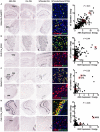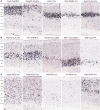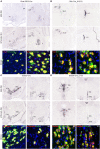Anatomical characterization of Cre driver mice for neural circuit mapping and manipulation
- PMID: 25071457
- PMCID: PMC4091307
- DOI: 10.3389/fncir.2014.00076
Anatomical characterization of Cre driver mice for neural circuit mapping and manipulation
Abstract
Significant advances in circuit-level analyses of the brain require tools that allow for labeling, modulation of gene expression, and monitoring and manipulation of cellular activity in specific cell types and/or anatomical regions. Large-scale projects and individual laboratories have produced hundreds of gene-specific promoter-driven Cre mouse lines invaluable for enabling genetic access to subpopulations of cells in the brain. However, the potential utility of each line may not be fully realized without systematic whole brain characterization of transgene expression patterns. We established a high-throughput in situ hybridization (ISH), imaging and data processing pipeline to describe whole brain gene expression patterns in Cre driver mice. Currently, anatomical data from over 100 Cre driver lines are publicly available via the Allen Institute's Transgenic Characterization database, which can be used to assist researchers in choosing the appropriate Cre drivers for functional, molecular, or connectional studies of different regions and/or cell types in the brain.
Keywords: Cre driver mice; anatomical characterization; genetic tools; in situ hybridization; neuronal cell types.
Figures







Similar articles
-
Genetically targeted binary labeling of retinal neurons.J Neurosci. 2014 Jun 4;34(23):7845-61. doi: 10.1523/JNEUROSCI.2960-13.2014. J Neurosci. 2014. PMID: 24899708 Free PMC article.
-
A robust and high-throughput Cre reporting and characterization system for the whole mouse brain.Nat Neurosci. 2010 Jan;13(1):133-40. doi: 10.1038/nn.2467. Epub 2009 Dec 20. Nat Neurosci. 2010. PMID: 20023653 Free PMC article.
-
Inhibitory neuron-specific Cre-dependent red fluorescent labeling using VGAT BAC-based transgenic mouse lines with identified transgene integration sites.J Comp Neurol. 2018 Feb 15;526(3):373-396. doi: 10.1002/cne.24343. Epub 2017 Nov 11. J Comp Neurol. 2018. PMID: 29063602
-
Cre Activated and Inactivated Recombinant Adeno-Associated Viral Vectors for Neuronal Anatomical Tracing or Activity Manipulation.Curr Protoc Neurosci. 2015 Jul 1;72:1.24.1-1.24.15. doi: 10.1002/0471142301.ns0124s72. Curr Protoc Neurosci. 2015. PMID: 26131660 Free PMC article. Review.
-
Pancreas-specific Cre driver lines and considerations for their prudent use.Cell Metab. 2013 Jul 2;18(1):9-20. doi: 10.1016/j.cmet.2013.06.011. Cell Metab. 2013. PMID: 23823474 Free PMC article. Review.
Cited by
-
Cell class-specific long-range axonal projections of neurons in mouse whisker-related somatosensory cortices.Elife. 2024 Oct 11;13:RP97602. doi: 10.7554/eLife.97602. Elife. 2024. PMID: 39392390 Free PMC article.
-
Bidirectional regulation of motor circuits using magnetogenetic gene therapy.Sci Adv. 2024 Oct 11;10(41):eadp9150. doi: 10.1126/sciadv.adp9150. Epub 2024 Oct 9. Sci Adv. 2024. PMID: 39383230 Free PMC article.
-
Pituitary adenylate cyclase-activating polypeptide (PACAP)+ cells in the paraventricular nucleus of the thalamus: relationship with binge-type eating in male and female mice.Psychopharmacology (Berl). 2024 Sep 28. doi: 10.1007/s00213-024-06692-9. Online ahead of print. Psychopharmacology (Berl). 2024. PMID: 39340653
-
Synaptic integration of somatosensory and motor cortical inputs onto spiny projection neurons of mice caudoputamen.Eur J Neurosci. 2024 Oct;60(8):6107-6122. doi: 10.1111/ejn.16538. Epub 2024 Sep 24. Eur J Neurosci. 2024. PMID: 39315531
-
Genetic approaches to elucidating cortical and hippocampal GABAergic interneuron diversity.Front Cell Neurosci. 2024 Jul 24;18:1414955. doi: 10.3389/fncel.2024.1414955. eCollection 2024. Front Cell Neurosci. 2024. PMID: 39113758 Free PMC article. Review.
References
Publication types
MeSH terms
Substances
LinkOut - more resources
Full Text Sources
Other Literature Sources
Molecular Biology Databases
Research Materials

